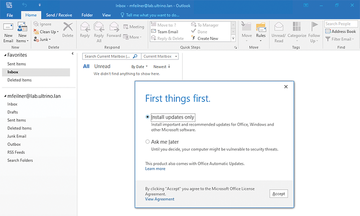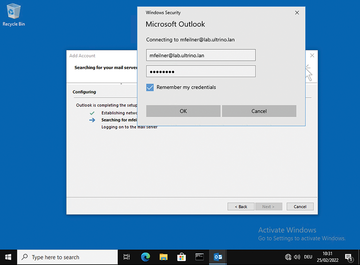« Previous 1 2 3 4
Microsoft Exchange replacement
Top Dog in Sight
What the Future Holds
Only a few months old, grommunio is already quite far down the road to becoming a true drop-in replacement for Exchange. Unlike its predecessors, it bundles open source and open standards services and promises to lead the way out of the vendor lock-in jungle. So far, however, admins are likely to be missing more detailed documentation [11] and a full-fledged, automated migration wizard. Grommunio is aware of these shortcomings and is already working intensively on both topics, as the latest updates on the website confirm. Moreover, the migration tools are currently updated frequently.
The Outlook connection (Figure 9) works without problems (Figure 10) but will still have to prove its capabilities in the coming months. The comparatively low prices (see the "Editions" box and Table 1) and the open source character of what is still fairly new software are likely to lower the inhibition threshold for users wanting to try out the groupware product. Extensive independent tests are still outstanding and would be important to back up the vendor's claims relating to speed, stability, scalability, and migration options. If grommunio stands up to the test and the developers deliver the missing features, then grommunio could become a real game changer on the groupware market. The approach definitely looks promising.
Table 1
Features at a Glance
| Manufacturer | grommunio GmbH |
|---|---|
| License | AGPLv3 |
| Price (per user/month) | Community (5 users or fewer) free, Basic (6-49) EUR1.99, Plus (6-49) EUR2.99, Business (50-999) EUR4.49, Enterprise (1000 or more) ask |
| Operating models | On-premises, cloud |
| Server OS | Linux |
| Groupware protocols | SMTP, IMAP, POP3, MAPI, RPC over HTTP, CalDAV, CardDAV, WebDAV, LDAP, Active Directory, Exchange ActiveSync (EAS), Exchange Cached Mode |
| Exchange Features | |
| Offline mode, public folders, categories and flags, webmail, global address lists | |
| Contacts | Support for all contact fields, multiple contact folders, contact groups, export |
| Calendar | Free/busy times, appointment invitations, recurring appointments and exceptions, shared calendars and delegations |
| Groupware Features | |
| Features | Notes, tasks (with time tracking), file synchronization and sharing (ownCloud), chat (Mattermost), video conferencing (Jitsi), office features (OnlyOffice), archive |
| Clients | Outlook (without plugin), all Exchange clients, web GUI, app (chat, video, files), email clients, calendar clients, global search |
| Other | |
| Architectures | High availability, sharding, multidomain, multitenancy, all POSIX-enabled storage back ends, AD forest installations |
| Security | S/MIME, remote wipe, OpenPGP, single sign-on (in development), two-factor authentication (2FA; in development), anti-spam, antivirus (third party) |
| Administration Features | |
| Installers | Installer ISO, OVA, image |
| MDM | Yes |
| Data migration | Export from Exchange/Kopano/ICAL/IMAP/POP3 to grommunio |
| White label/branding | Yes |
| App stores | No |
Editions
Grommunio's free Community subscription provides accounts for five users with basic features such as groupware and mobile device management. The Basic version includes email or web support. Professional users who need telephony support need to purchase the Plus edition. For enterprise customers, the Business subscription has all features, including high availability. Customers who need round-the-clock support have to request this, and it is the only difference between the business and enterprise licenses, apart from the targeted company size. For science, education, public service, government, and NGOs, grommunio grants discounts of up to 25 percent. Hosters can also receive a licensing program specifically tailored to their needs.
 Figure 9: After creating users and domains, connecting Outlook users is a smooth process. Microsoft's email client thinks it is talking to an Exchange server.
Figure 9: After creating users and domains, connecting Outlook users is a smooth process. Microsoft's email client thinks it is talking to an Exchange server.
Infos
- grommunio: http://grommunio.com/
- Autodiscover flaw in Microsoft Exchange leaking credentials: https://www.techtarget.com/searchsecurity/news/252507119/Autodiscover-flaw-in-Microsoft-Exchange-leaking-credentials
- MAPI: https://en.wikipedia.org/wiki/MAPI
- End of REST API on-premises mailboxes preview: https://techcommunity.microsoft.com/t5/exchange-team-blog/the-end-of-the-rest-api-for-on-premises-mailboxes-preview/ba-p/3221219
- MAPI over HTTP: https://docs.microsoft.com/en-us/Exchange/clients/mapi-over-http/mapi-over-http?view=exchserver-2019
- GitHub: https://github.com/grommunio
- Repository: https://grommunio.com/download/
- Community repositories: https://download.grommunio.com/community/packages/
- grommunio openSUSE Build Server: https://build.grommunio.com
- PowerShell migration script: https://github.com/grommunio/gromox/blob/master/tools/exchange2grommunio.ps1
- Documentation: https://docs.grommunio.com
« Previous 1 2 3 4
Buy this article as PDF
(incl. VAT)
Buy ADMIN Magazine
Subscribe to our ADMIN Newsletters
Subscribe to our Linux Newsletters
Find Linux and Open Source Jobs
Most Popular
Support Our Work
ADMIN content is made possible with support from readers like you. Please consider contributing when you've found an article to be beneficial.








